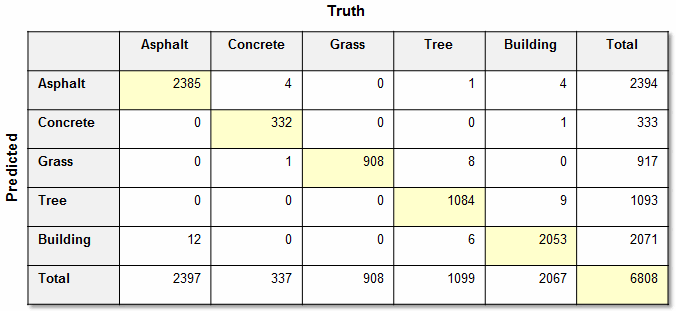The Accuracy function method returns the overall accuracy of a confusion matrix.
The overall accuracy is calculated by summing the number of correctly classified values and dividing by the total number of values. The correctly classified values are located along the upper-left to lower-right diagonal of the confusion matrix. The total number of values is the number of values in either the truth or predicted-value arrays.
In the example confusion matrix, the overall accuracy is computed as follows:
Correctly classified values: 2385 + 332 + 908 + 1084 + 2053 = 6762
Total number of values: 6808
Overall accuracy: 6762 / 6808 = 0.993243

Example
The code example below evaluates classifications using a confusion matrix.
PRO EvaluateClassificationUsingConfusionMatrix
COMPILE_OPT IDL2
e = ENVI()
File = Filepath('qb_boulder_msi', Subdir=['data'], $
Root_Dir=e.Root_Dir)
Raster = e.OpenRaster(File)
File2 = Filepath('qb_boulder_roi.xml', Subdir=['data'], $
Root_Dir=e.Root_Dir)
Rois = envi.OpenROI(roiFile)
StatTask = ENVITask('ROIStatistics')
StatTask.INPUT_RASTER = Raster
StatTask.INPUT_ROI = Rois
StatTask.Execute
Task = ENVITask('MahalanobisDistanceClassification')
Task.INPUT_RASTER = Raster
Task.COVARIANCE = StatTask.Covariance
Task.MEAN = StatTask.Mean
Task.CLASS_PIXEL_COUNT = StatTask.Roi_Pixel_Count
Task.CLASS_NAMES = [Rois[0].name, Rois[1].name, Rois[2].name]
Task.CLASS_COLORS = [[0,0,255], [0,255,0], [255,0,0]]
Task.Execute
ClassRaster = Task.OUTPUT_RASTER
View = e.GetView()
Layer = View.CreateLayer(ClassRaster)
envi.Data.Add, ClassRaster
ConfusionMatrix = ENVICalculateConfusionMatrixFromRaster(ClassRaster, Rois)
Print, 'Confusion Matrix:'
Print, ConfusionMatrix.Confusion_Matrix
Print, 'Errors of commission: '
Print, Transpose([[ConfusionMatrix.Column_Names+': '], [(ConfusionMatrix.CommissionError()).ToString()]])
Print, 'Errors of omission: '
Print, Transpose([[ConfusionMatrix.Column_Names+': '], [(ConfusionMatrix.OmissionError()).ToString()]])
Print, 'Overall accuracy: ', ConfusionMatrix.Accuracy()
END
Syntax
Result = ENVIConfusionMatrix.Accuracy([, ERROR=variable])
Return Value
This function method returns the overall accuracy from a confusion matrix.
Arguments
None
Keywords
ERROR (optional)
Set this keyword to a named variable that will contain any error message issued during execution of this routine. If no error occurs, the ERROR variable will be set to a null string (''). If an error occurs and the routine is a function, then the function result will be undefined.
When this keyword is not set and an error occurs, ENVI returns to the caller and execution halts. In this case, the error message is contained within !ERROR_STATE and can be caught using IDL's CATCH routine. See IDL Help for more information on !ERROR_STATE and CATCH.
See Manage Errors for more information on error handling in ENVI programming.
Version History
See Also
ENVIConfusionMatrix